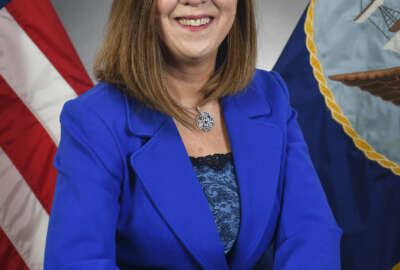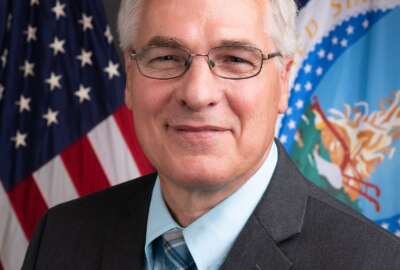Hubbard Radio Washington DC, LLC. All rights reserved. This website is not intended for users located within the European Economic Area.
EPA acquisitions leader receives Presidential Rank Award
Best listening experience is on Chrome, Firefox or Safari. Subscribe to Federal Drive’s daily audio interviews on Apple Podcasts or PodcastOne.
When it comes to acquisition, Kimberly Patrick has done it all. She used lean management to reduce backlogs and speed up procurements, brought senior agency management into acquisition planning, found innovative ways to meet small business goals. She’s the director of Office of Acquisition Solutions, Office of Mission Support at the EPA, and the recent recipient of...
Best listening experience is on Chrome, Firefox or Safari. Subscribe to Federal Drive’s daily audio interviews on Apple Podcasts or PodcastOne.
When it comes to acquisition, Kimberly Patrick has done it all. She used lean management to reduce backlogs and speed up procurements, brought senior agency management into acquisition planning, found innovative ways to meet small business goals. She’s the director of Office of Acquisition Solutions, Office of Mission Support at the EPA, and the recent recipient of a Presidential Rank Award. She joined the Federal Drive with Tom Temin for more information.
Interview transcript:
Tom Temin: One of the things I wanted to discuss is mentioned in your citation is that the idea of tying acquisition directly to the mission owners and mission leaders at EPA, so often you hear, acquisition is siloed, and not really connected in that way. Tell us more about that.
Kimberly Patrick: Actually, it’s essential. I don’t know how sound acquisition is even placed if your mission partners are not integrally involved in the acquisition itself. Acquisitions doesn’t really exist in the federal space, unless there’s a mission, really to be accomplished. I think our biggest mission partners that we work with at EPA is our Office of Land and Emergency Management, which houses the agency’s Superfund program, and I think that the partnership that we have with them is incredibly strong. And that even at their senior management levels, they’re very much involved in shaping and driving the acquisitions. And even with our regional Superfund directors, they’re also very much involved with the regional contracting offices, and shaping acquisitions to support the program.
Tom Temin: And give us a sense of the types of acquisitions, the types of products and services needed for Superfund. Is it like professional services is a big diggers and dump trucks or what?
Kimberly Patrick: It’s all of that, you name it. We look at the remedial program itself. You have design and engineering, you have architectural services, you have construction work, and that includes, you know, moving earth, dumping earth, finding places to put hazardous materials, all of those things, it’s a huge landscape of need that is out there. And the businesses that we partner with and work with to make the program successful run the gamut. You have very small businesses who may just take dump trucks of dirt from here to there. And then you have incredibly large architectural engineering firms that also work on these projects, which sometimes can span 20 years.
Tom Temin: And your 1102s that do the actual contracting and have to have some knowledge about this industry. What about the contracting officer representatives, the core, they must be pretty specialized in the EPA.
Kimberly Patrick: They are essential. I will say that while the CEO has the warrant, and combined the government, it’s the core that really does the management the contract once it’s paced. And it’s essential to have a cadre of strong cores. And one of the things that I’ve been pretty insistent about since I’ve been the director of the contract shop, is that the agency needs to do more to strengthen the core capability. And to actually invest more in the core function. Sometimes you’ll find cores where that core work is only 25% of their job. But when you actually talk to them and ask how much does this take up to manage, especially a large contract effectively, sometimes it’s up to 75 to 80%, if not all of their job, there should be moves not just at EPA, I think across the government, to do more to really almost professionalized what cores do. Because if they’re dealing with large contracts, or really active contracts, it’s incredibly time consuming.
Tom Temin: And also EPA has been on a mission, you might say, to upgrade its information technology systems, use more cloud computing, because, you know, a few years ago, they were found to be fairly dated in the way the IT works. So I imagine you’ve got to have expertise in that industry, which is miles from the remediation and cleanup and environmental direct work types of companies.
Kimberly Patrick: You know, one of the things we did when we had our reorganization in 2017, which I was only a year in and we did a major reorg of the contract shop. But we moved to organize the office by commodity. And so we developed a unit in my organization that does nothing but IT contracting. And that was to help develop their expertise to do exactly what you said, they need to have a knowledge of what’s available, they need to know the market to be able to service the customer. And so we did that, so that they could develop that because it wasn’t innately there. It’s something that had to be learned. And so it’s a process and we’re still working hard to get to the point where we know the market almost better than our IT shop does. But we have a good partnership with our IT shop. We’re developing the relationship and we try to work together to make sure everyone stays on the cutting edge. I think EPA has come a long way in the IT area and I have to give some credit to my colleague and OMS, Vaughn Noga who’s also a fellow Presidential Rank Award winner and that he’s brought so much innovation and change to that space. And EPA has grown light years because of his leadership, as well.
Tom Temin: And Vaughn has been on this show, as well too, talking about some of those things over the years. We’re speaking with Kimberly Patrick. She’s director of the office of acquisition solutions at the EPA, and also a Presidential Rank Award recipient this year. And I wanted to ask you about your work in bringing in small business and small disadvantaged business kind of a subset. And you’ve met the goals. And those goals are rising government-wide because of orders from the Biden administration. So what are some of your strategies been to really foster that because you’ve had some creative work there.
Kimberly Patrick: At EPA, our history in performing incredibly well, with small businesses and with small disadvantaged businesses is well documented. I would say for maybe the last 10 years, we’ve received an A on the SBA scorecard for our performance. And the small disadvantaged business goal is one that we’ve always met. While historically, that goal has been 5% for the federal government. And now I believe it’s 11%. That’s not something that shakes us, for example, last year for FY 21, we performed at 18%, for small disadvantaged businesses. And the individual goal of the agency received for 2022, from SBA for small disadvantaged businesses is at 17. And so for us, it’s about continuing to do what works. But in addition to that, given the executive order on equity, there’s a piece in there for procurement that’s very strong. And so we’ve been working to come up with some innovative techniques to reach out to those underserved and underrepresented businesses, regardless of category. And so we’re not just looking at strategies for small disadvantaged businesses, it’s all of the socioeconomic categories, where they have lacked a lot of attention and need more, even though we’re doing well.
Kimberly Patrick: Some of the things that we’re looking at doing, it’s instituting a process for anonymous technical evaluation panels. EPA loves its contractors, and we love them. But sometimes when we have a contractor who’s been in business with us for 40 years working the same work, you’re not expanding your market. And so we want to make sure that a lot of times our newer businesses, which are our smaller businesses, have the opportunity to compete technical capability to technical capability, and not always relying on name brand, or what’s familiar. And so we’re working on putting that policy in place. And we recently had a listening session with industry about shaping that policy. So we’re excited about that.
Another thing we want to do when we listened to the underserved community, we asked them, what are some of their barriers that they saw. And one of the biggest ones that we heard was they don’t have access to EPA decision makers so that they can know what their capabilities are. And in my mind, I said that’s something easy to fix. And so we’re doing efforts to actually establish targets for senior leadership to actually participate in engagement with the businesses because I do believe once they know what the capabilities are, that’s going to move the needle. And so we’re excited about where we’re going with that. Another thing we’re doing as we are shaping our outreach events, we’re trying to make them targeted to our forecasts. So when we talk about doing business with EPA, we can talk about actual procurements that we see on the horizon, making the conversation more meaningful for the businesses when they know that there’s an actual opportunity that can come out of the conversation.
Tom Temin: And let me just ask a question, based on something I’ve seen over the decades following this. Very often, there are companies that will have a principle that is of color, or of one of the SBD categories. But in reality, there’s a lot of just regular folks backing it. And kind of it’s a way to get in, is there a way to get at those numbers and actually develop? I mean, there’s a bigger purpose here than just a type of company, but is making sure that all Americans have the technical and business skills needed to participate just equally across the board. How do you get past that kind of front end appearance of SBD that might meet a legal requirement, but doesn’t meet what you’re really trying to do there?
Kimberly Patrick: You know, that’s been a criticism of the SBD program for a very long time, because it is a self-certification program. It is not something where you go through the rigor that you know, the 8A program or the HUBZone program does at SBA. And so it’s one of those things quite honestly, you take the risk. Frankly, there’s not a whole lot you can do about people who choose to be dishonest. But one thing I found in working with industry, it never fails that your competition will tell on you, and they will very much, I guess, challenge some of the assertions if that’s the case. But one of the things that we’re doing instead of focusing on the potential for people to be dishonest, we’re broadening the conversation. So we’re not just focusing on SDBs. As I mentioned before, because we do so well in that category, we’re really honing in on HUBZones. We’re really honing in on 8A, we’re honing in on some of the other categories as well, which are also SDBs. But these are categories that have a certification, and my particular love for the HUBZone program is that not only is it a certified program, but it also impacts communities and that the people who work at the businesses 35% have to live in a HUBZone. And so it’s a program that really targets and hits on so many other things beyond just, here’s the contract. It’s about jobs as well. And so that’s one of the things we’re doing to sort of broaden the conversation to make sure we’re capturing not just those who check that box sometimes and are SDBs. But we’ve also found honestly, we’ve found more companies that are legitimately SDBs, that we have those that have been dishonest. The instances where we found that are so rare. And I hope that’s reflective of people’s honesty, even though there is the potential for people to take advantage sometimes because it’s a self-certification.
Tom Temin: And finally, your thoughts on Senior Executive Service, federal career and being a woman of color who has come up through the ranks to reach Presidential Rank Award status.
Kimberly Patrick: Wow, that’s a loaded question, Tom. Well, one thing I can say, and this is gonna sound incredibly corny, but I’m gonna say it anyway, true leadership is a calling. And what I found is, it’s something you can’t escape or ignore. It’s funny, I never necessarily set out, I didn’t say I’m going to be an SES when I started my federal career. I took pride and joy in each and every job I had, even when there were rough days. And so my focus has always been and I remember listening to my mom, that everything you do should do with excellence, and you do it well. And if you’re not going to do it well, don’t do it. And that is something that no matter what assignment I’ve been given, is something that I’ve done throughout my career. When I talk to others who aspire to the SES, I tell them, the focus isn’t on being SES, the focus is on being willing to do some things and take those those projects nobody else wants to do Don’t run from what’s difficult one to it, and have a solution for it. Don’t stand on the sidelines complaining; get involved and be a part of change. And so that’s sort of been my mantra. And when I started every time I’ve been selected to move to the next level, I rest well in knowing it’s been because of my work, and not necessarily because of who I knew and all those other things people want to tell you it’s really about, it’s not, not always. And when you get there, what I call the right way, people can’t take it from you because you’ve built it on your work. And that’s the focus.
Tom Temin
Tom Temin is host of the Federal Drive and has been providing insight on federal technology and management issues for more than 30 years.
Follow @tteminWFED






